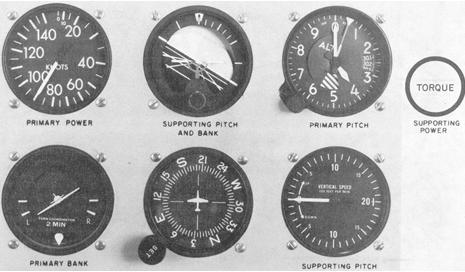
Standard Rate Turns. Turns made by reference to instruments should be made at a definite rate. Turns described in this section are those which do not exceed a standard rate of three degrees per second as indicated by the turn coordinator. True airspeed determines the angle of bank necessary to maintain a standard rate turn. At 70 knots true airspeed, approximately 12 degrees of bank are required to maintain a standard rate turn; at 90 knots true airspeed, approximately 15 degrees of bank are required.
To enter a turn, apply lateral cyclic in the direction of the desired turn. The entry should be accomplished smoothly, using the attitude indicator to establish the approximate bank angle. When the turn coordinator indicates a standard rate turn, it becomes primary for bank. The attitude indicator now becomes supporting for bank. During level turns, the altimeter is primary for pitch and the airspeed indicator is primary for power. Primary and supporting instruments for a stabilized standard rate turn are illustrated in Figure 6-11. If an increase in torque is required to maintain airspeed, slight forward cyclic pressure may be required since the helicopter tends to pitch up as collective pitch angle is changed. Apply pedal trim as required to keep the ball centered.
Figure 6-11. Standard rate turn - constant airspeed.
 |
To recover to straight-and-level flight, apply cyclic in the direction opposite the turn. The rate of roll-out should be the same as the rate of roll-in. As you initiate the turn recovery, the attitude indicator becomes primary for bank. When the helicopter is approximately level, the heading indicator becomes primary for bank as in straight-and-level flight. The airspeed indicator and ball should be cross-checked closely to maintain desired airspeed and pedal trim.
Turns to Predetermined Headings - As was stated earlier, turning and banking in coordinated flight are the same. A helicopter will turn as long as its lateral axis is tilted; therefore, the recovery must start before the desired heading is reached. The amount of lead varies with the rate of turn and the individual pilot's rate of recovery.
As a guide, when making a 3 degree per second rate of turn, use a lead of one-half the angle of bank. Use this lead until you are able to determine the exact amount required by your particular technique. The bank angle should never exceed the number of degrees to be turned. As in any standard rate turn, the rate of recovery should be the same as the rate of entry. During turns to predetermined headings, cross-check the primary and supporting pitch, bank, and power instruments closely.
Timed Turns, Compass Turns, and Changes of Airspeed in Turns. The procedures for performing these maneuvers in a helicopter and an airplane are essentially the same. See the descriptions in Chapter V.
Steep Turns. Any turn greater than a standard rate is considered a steep turn. In helicopters, steep turns should be limited to one and a half times a standard rate turn as indicated by the turn coordinator. A steep turn is seldom necessary or advisable in instrument weather conditions, but it is an excellent maneuver to increase your ability to react quickly and smoothly to rapid changes of attitude.
Regardless of the bank angle used, the entry and recovery techniques are the same as for any turn. You will find it more difficult to control pitch because of the greater decrease of vertical lift as the bank increases. With some attitude indicators, precession while in a steep turn adds to the difficulty of maintaining the desired attitude. There is a tendency to lose altitude and/or airspeed in steep turns because of the decrease of vertical lift. Therefore, to maintain a constant altitude and airspeed, additional power will be required. You should not initiate a correction, however, until the instruments indicate the need for a correction.
Figure 6-12. Steep left turn.
 |
Refer to the attitude indicator when making a correction even though precession of the instrument is evident. Note the need for a correction on the altimeter and vertical-speed indicator, check the indications on the attitude indicator, and make the necessary change. After you have made this change, again check the altimeter and vertical-speed indicator to determine whether or not the correction was adequate. The primary and supporting instruments for a stabilized steep turn are illustrated in Figure 6-12.
The recovery should be smooth with a normal rate of roll-out. As the helicopter rolls out of the turn, vertical lift will increase and there will be a tendency to climb. Also, there will be a tendency for the airspeed to increase. Necessary corrections should be made as soon as the need is indicated by the instruments.
Climbing and Descending Turns. For climbing and descending turns, the techniques described earlier for straight climbs and descents and those for standard rate turns are combined. For practice, start the climb or descent and turn simultaneously. The primary and supporting instruments for a stabilized constant airspeed left climbing turn are illustrated in Figure 6-13. The level off from a climbing or descending turn is the same as the level off from a straight climb or descent. To recover to straight-and-level flight, you may: (1) stop the turn, then level off; (2) level off, then stop the turn; or (3) stop the turn and level off simultaneously. During climbing and descending turns, keep the ball of the turn coordinator centered with pedal trim.